Surface Displacements Mechanism of the Dobi Graben from ASAR Time-Series Analysis of InSAR: Implications for the Tectonic Setting in the Central Afar Depression, Ethiopia
Abstract
:1. Introduction
2. Materials and Methods
2.1. ENVI SarScape® Small BAseline Subset Algorithm (SBAS)
2.2. Available GPS Data and Broadband Seismic Data
3. Results
3.1. Post-InSAR Analysis and Quality Control
3.2. The Line of Sight (LOS) of Displacement Using Ascending Tract 257
3.3. The LOS of Displacement Using Descending Tract 006
4. Discussion
5. Conclusions
6. Patents
Supplementary Materials
Author Contributions
Funding
Acknowledgments
Conflicts of Interest
References
- Tapponnier, P.; Armijo, R.; Manighetti, I.; Courtillot, V. Bookshelf faulting and horizontal block rotations between overlapping rifts in Southern Afar. Geophys. Res. Lett. 1990, 17, 1–4. [Google Scholar] [CrossRef]
- Manighetti, I.; Tapponnier, P.; Courtillot, V.; Gallet, Y.; Jacques, E.; Gillot, P.Y. Strain transfer between disconnected, propagating rifts in Afar. J. Geophys. Res. Solid Earth 2001, 106, 13613–13665. [Google Scholar] [CrossRef]
- Kidane, T.; Courtillot, V.; Manighetti, I.; Audin, L.; Lahitte, P.; Quidelleur, X.; Gillot, P.-Y.; Gallet, Y.; Carlut, J.; Haile, T. New paleomagnetic and geochronologic results from Ethiopian Afar: Block rotations linked to rift overlap and propagation and determination of a ~2 Ma reference pole for stable Africa. J. Geophys. Res. 2003, 108, 2102. [Google Scholar] [CrossRef] [Green Version]
- Demissie, Z.S.; Kevin, M.; Bridges, D.; Abdelsalam, M.G.; Atekwana, E.A. Upper lithospheric structure of the Dobi graben, Afar Depression from magnetic and Gravity data. J. Afr. Earth Sci. 2018, 147, 136–151. [Google Scholar] [CrossRef]
- Buck, W.R. Modes of continental lithospheric extension. J. Geophys. Res. 1991, 96, 20161–20178. [Google Scholar] [CrossRef]
- Buck, W.R. Consequences of Asthenospheric Variability on Continental Rifting, in Rheology and Deformation of the Lithosphere at Continental Margins; Columbia University Press: New York, NY, USA, 2004; Volume 62, pp. 1–30. [Google Scholar]
- Buck, W.R. The role of magma in the development of the Afro-Arabian Rift System. Geol. Soc. Lond. Spec. Publ. 2006, 259, 43–54. [Google Scholar] [CrossRef]
- Corti, G.; Bonini, M.; Conticelli, S.; Innocenti, F.; Manetti, P.; Sokoutis, D. Analogue modelling of continental extension: A review focused on the relations between the patterns of deformation and the presence of magma. Earth Sci. Rev. 2003, 63, 169–247. [Google Scholar] [CrossRef]
- Grandin, R.; Socquet, A.; Jacques, E.; Mazzoni, N.; de Chabalier, J.-B.; King, G.C.P. Sequence of rifting in Afar, Manda-Hararo rift, Ethiopia, 2005–2009: Time-space evolution and interactions between dikes from interferometric synthetic aperture radar and static stress change modeling. J. Geophys. Res. 2010, 115, B10413. [Google Scholar] [CrossRef] [Green Version]
- Belachew, M.; Ebinger, C.; Cote, D.; Keir, D.; Rowland, J.V.; Hammond, O.S.; Ayele, A. Comparison of dike intrusions in an incipient seafloor-spreading segment in Afar, Ethiopia: Seismicity perspectives. J. Geophys. Res. 2011, 116. [Google Scholar] [CrossRef] [Green Version]
- Ebinger, C.; van Wijk, J.J.; Keir, D. The time scales of continental rifting: Implications for global processes. Geol. Soc. Am. Spec. 2013, 500, 371–396. [Google Scholar] [CrossRef]
- Jacques, E.; Kidane, T.; Tapponnier, P.; Manighetti, I.; Gaudemer, Y.; Meyer, B.; Ruegg, J.C.; Audin, L.; Armijo, R. Normal faulting during the August 1989 earthquakes in Central Afar: Sequential triggering and propagation of rupture along the Dobi Graben. Bull. Seismol. Soc. Am. 2011, 101, 994–1023. [Google Scholar] [CrossRef]
- Pagli, C.; Yun, S.; Ebinger, C.; Keir, D.; Wang, H. Strike-slip tectonics during rift linkage. Geology 2019, 47, 31–34. [Google Scholar] [CrossRef]
- Acocella, V.; Yoshida, T.; Yamada, R.; Funiciello, F. Structural control on late Miocene to Quaternary volcanism in the NE Honshu arc, Japan. Tectonics 2008, 27. [Google Scholar] [CrossRef]
- Manighetti, I.; Tapponnier, P.; Gillot, P.Y.; Jacques, E.; Courtillot, V.; Armijo, R.; Ruegg, J.-C.; King, G. Propagation of rifting along the Arabia-Somalia plate boundary: Into Afar. J. Geophys. Res. Solid Earth 1998, 103, 4947–4974. [Google Scholar] [CrossRef]
- McKenzie, D.P.; Davies, D.; Molnar, P. Plate tectonics of the Red Sea and East Africa. Nature 1970, 226, 243–248. [Google Scholar] [CrossRef]
- Barberi, F.; Varet, J. The Erta Ale volcanic range (Danakil depression, northern Afar, Ethiopia). Bull. Volcanol. 1970, 36, 848–917. [Google Scholar] [CrossRef]
- Acton, G.D.; Stein, S.; Engeln, J. Block rotation and continental extension in Afar: A comparison to oceanic microplate systems. Tectonics 1991, 10, 501–526. [Google Scholar] [CrossRef]
- Eagles, G.; Gloaguen, R.; Ebinger, C. Kinematics of the Danakil microplate. Earth Planet. Sci. Lett. 2002, 203, 607–620. [Google Scholar] [CrossRef] [Green Version]
- Courtillot, E.V. Opening of the Gulf of Aden and Afar by progressive tearing. Phys. Earth Planet. 1980, 21, 343–350. [Google Scholar] [CrossRef]
- Souriot, T.; Brun, J.P. Faulting and block rotation in the Afar triangle: The Danakil “crank arm” model. Geology 1992, 20, 911–914. [Google Scholar] [CrossRef]
- Collet, B.; Taud, H.; Parrot, J.F.; Bonavia, F.; Chorowicz, J. A new kinematic approach for the Danakil block using a Digital Elevation Model representation. Techtonophysics 2000, 316, 343–357. [Google Scholar] [CrossRef]
- Lahitte, P.; Gillot, P.-Y.; Kidane, T.; Courtillot, V.; Bekele, A. New age constraints on the timing of volcanism in central Afar, in the presence of propagating rifts. J. Geophys. Res. 2003, 108, 2123. [Google Scholar] [CrossRef]
- Garfunkel, Z.; Beyth, M. Constraints on the structural development of Afar imposed by the kinematics of the major surrounding plates, in The Afar Volcanic Province within the East African Rift System. Geol. Soc. Lond. Spec. Publ. 2006, 259, 23–42. [Google Scholar] [CrossRef]
- Mohr, P.A. Ethiopian rift and plateaus: Some volcanic petrochemical differences. J. Geophys. Res. 1971, 76, 1967–1984. [Google Scholar] [CrossRef] [Green Version]
- Abbate, E.; Passerini, P.; Zan, L. Strike-slip faults in a rift area: A transect in the Afar Triangle, East Africa. Tectonophysics 1995, 241, 67–97. [Google Scholar] [CrossRef]
- Hoffstetter, R.; Beyth, M. The Afar Depression: Interpretation of the 1960-2000 earthquakes. Geophys. J. Int. 2003, 155, 715–732. [Google Scholar] [CrossRef] [Green Version]
- McClusky, S.; Reilinger, R.; Ogubazghi, G.; Amleson, A.; Healeb, B.; Vernant, P.; Kogan, L. Kinematics of the southern Red Sea-Afar Triple Junction and implications for plate dynamics. Geophys. Res. Lett. 2010, 37. [Google Scholar] [CrossRef] [Green Version]
- Saria, E.; Calais, E.; Stamps, D.; Delvaux, D.; Hartnady, C. Present-day kinematics of the East African Rift. J. Geophys. Res. 2014, 119, 3584–3600. [Google Scholar] [CrossRef]
- Hayward, N.J.; Ebinger, C.J. Variations in the along-axis segmentation of the Afar Rift system. Tectonics 1996, 15, 244–257. [Google Scholar] [CrossRef]
- Doubre, C.; Peltzer, G. Fluid-controlled faulting process in the Asal Rift, Djibouti, from 8 yr of radar interferometry observations. Geology 2007, 35, 69–72. [Google Scholar] [CrossRef]
- Bridges, D.L.; Mickus, K.; Gao, S.S.; Abdelsalam, M.G.; Alemu, A. Magnetic stripes of a transitional continental rift in Afar. Geology 2012, 40, 203–206. [Google Scholar] [CrossRef]
- Berardino, P.; Fornaro, G.; Lanari, R.; Sansosti, E. A new algorithm for surface deformation monitoring based on small baseline differential SAR interferograms. IEEE Trans. Geosci. Remote Sens. 2002, 40, 2375–2383. [Google Scholar] [CrossRef] [Green Version]
- Vassileva, M.; Tonolo, F.G.; Riccardi, P.; Lecci, D.; Boccardo, P.; Chiesa, G. Satellite SAR interferometric techniques in support to emergency mapping. Eur. J. Remote Sens. 2017, 50, 464–477. [Google Scholar] [CrossRef] [Green Version]
- Hooper, A.; Segall, P.; Zebker, H. Persistent scatterer interferometric synthetic aperture radar for crustal deformation analysis, with application to Volcán Alcedo, Galápagos. J. Geophys. Res. 2007, 112. [Google Scholar] [CrossRef] [Green Version]
- Ghulam, A.; Grzovic, M.; Maimaitijiang, M.; Sawut, M. InSAR monitoring of land subsidence for sustainable urban planning. In Remote Sensing for Sustainability; Weng, Q., Ed.; CRC Press: Boca Raton, FL, USA, 2016. [Google Scholar]
- Peltzer, G.; Crampe, F.; Hensley, S.; Rosen, P. Transient strain accumulation and fault interaction in the Eastern California shear zone. Geology 2001, 29, 975–978. [Google Scholar] [CrossRef]
- Costantini, M.; Falco, S.; Malvarosa, F.; Minati, F. A New Method for Identification and Analysis of Persistent Scatterers in Series of SAR Images. IEEE Trans. Geosci. Remote Sens. 2008, 2, II-449. [Google Scholar] [CrossRef]
- Deprez, A.; Doubre, C.; Masson, F.; Ulrich, P. Erratum: Seismic and aseismic deformation along the East African Rift System from a reanalysis of the GPS velocity field of Africa. Geophys. J. Int. 2015, 200, 556. [Google Scholar] [CrossRef] [Green Version]
- Sarmap. Getting Started with SARscape for Windows. Available online: https://www.sarmap.ch/tutorials/Getting_started.pdf (accessed on 22 February 2022).
- Doubre, C.; Deprez, A.; Masson, F.; Socquet, A.; Lewi, E.; Grandin, R.; Nercessian, A.; Ulrich, P.; Chabalier, D.J.; Saad, I.; et al. Current deformation in Central Afar and triple junction kinematics deduced from GPS and InSAR measurements. Geophys. J. Int. 2016, 208, 936–953. [Google Scholar] [CrossRef]
- Reed, C.A.; Almadani, S.; Gao, S.; Elsheikh, A.A.; Cherir, S.; Abdelsalam, M.G.; Thurmond, A.K.; Liu, K.H. Receiver function constraints on crustal seismic velocities and partial melting beneath the Red Sea rift and adjacent regions, Afar Depression. J. Geophys. Res. 2014, 119, 2138–2152. [Google Scholar] [CrossRef]
- Just, D.; Bamler, R. Phase statistics of interferograms with applications to synthetic aperture radar. Appl. Opt. 1994, 33, 4361–4368. [Google Scholar] [CrossRef]
- Jacques, E.; Ruegg, J.C.; Lépine, J.C.; Tapponnier, P.; King, G.C.P.; Omar, A. Relocation of M ≥ 2 events of the 1989 Dôbi seismic sequence in Afar: Evidence for earthquake migration. Geophys. J. Int. 1999, 138, 447–469. [Google Scholar] [CrossRef] [Green Version]
- Courtillot, V.; Achache, J.; Landre, F.; Bonhommet, N.; Montigny, R.; Féraud, G. Episodic spreading and rift propagation: New paleomagnetic and geochronologic data from the Afar nascent passive margin. J. Geophys. Res. 1984, 89, 3315–3333. [Google Scholar] [CrossRef]
- Gupta, A.; Scholz, H.C. Brittle strain regime transition in the Afar depression: Implications for fault growth and seafloor spreading. Geology 2000, 28, 1087–1090. [Google Scholar] [CrossRef] [Green Version]

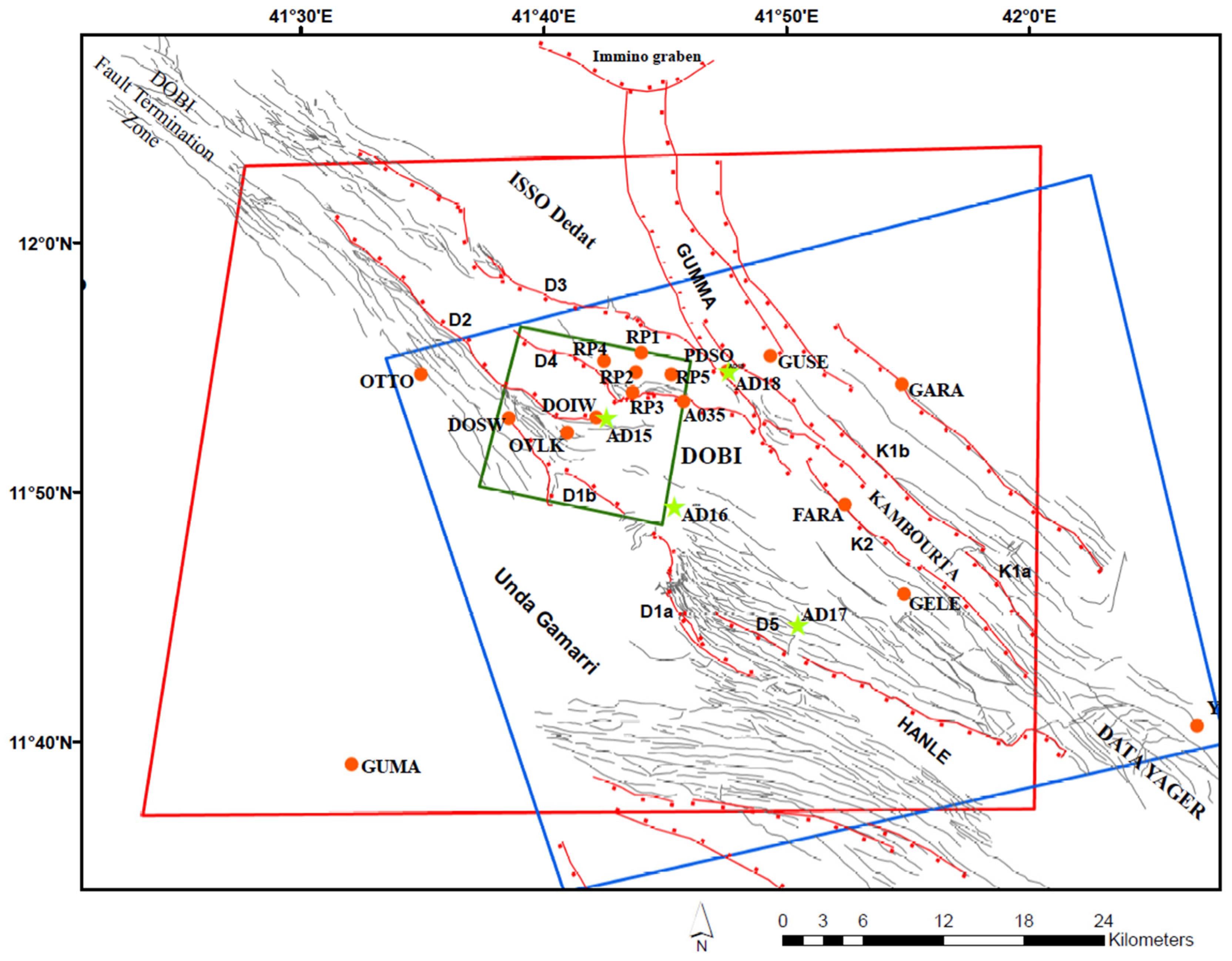
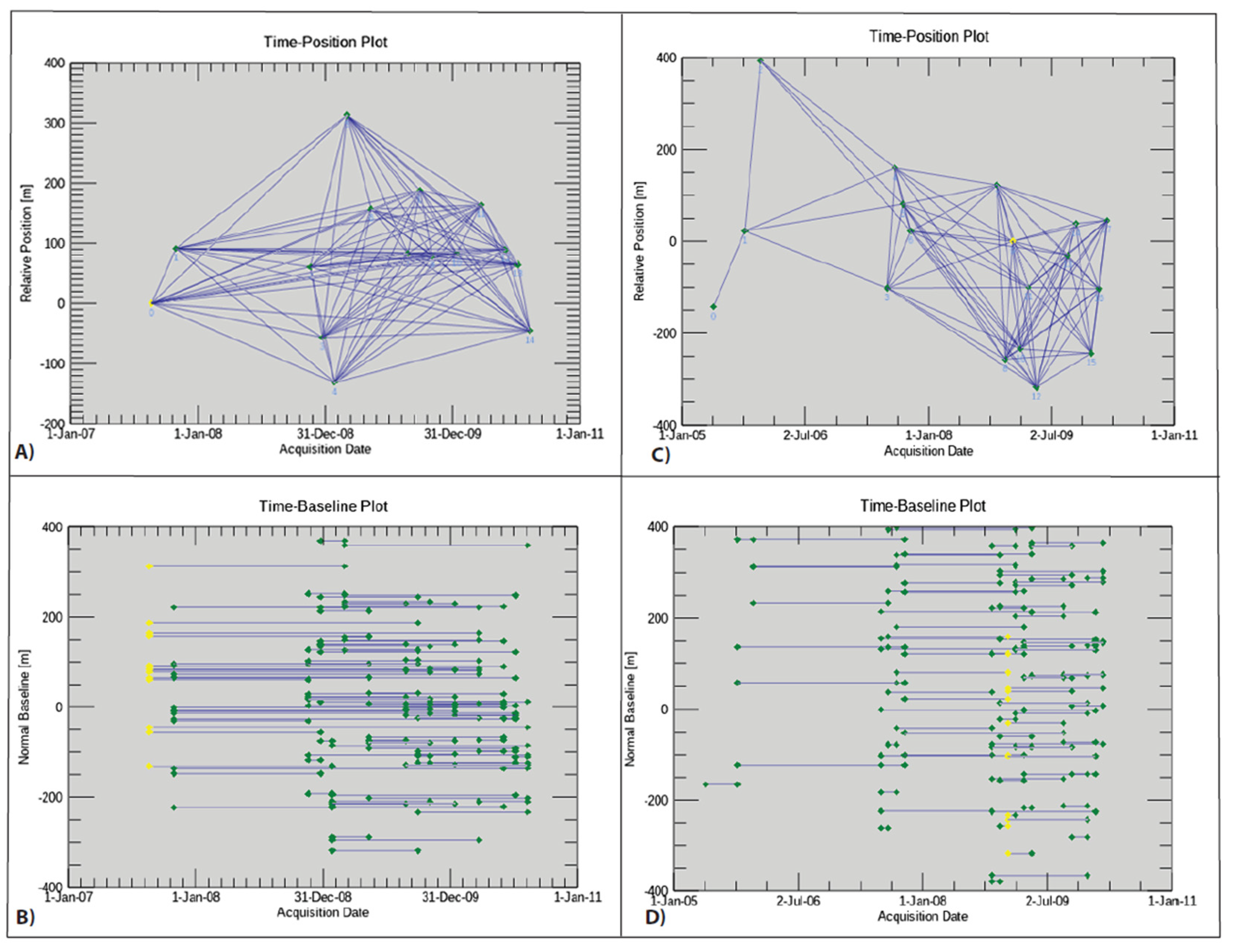
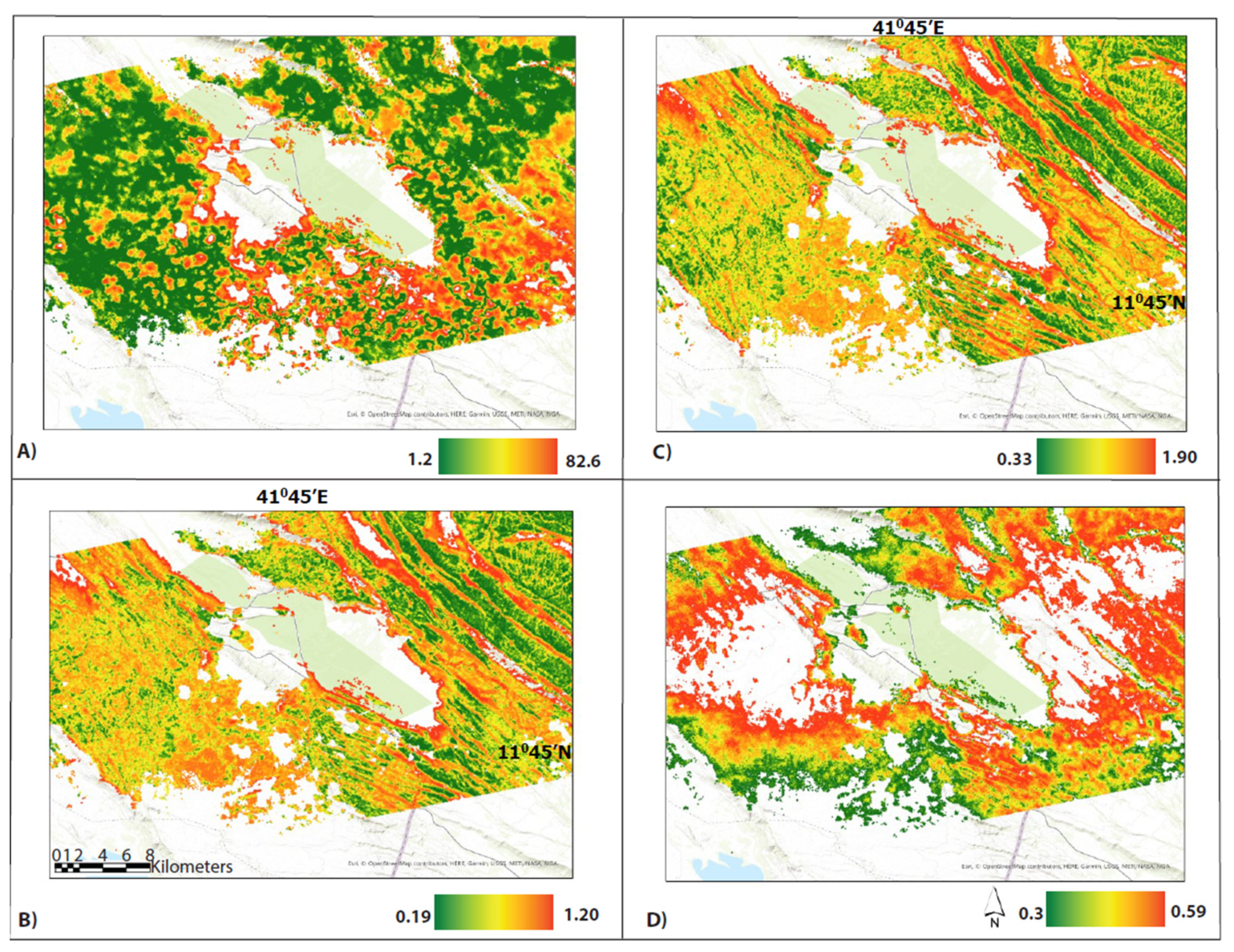




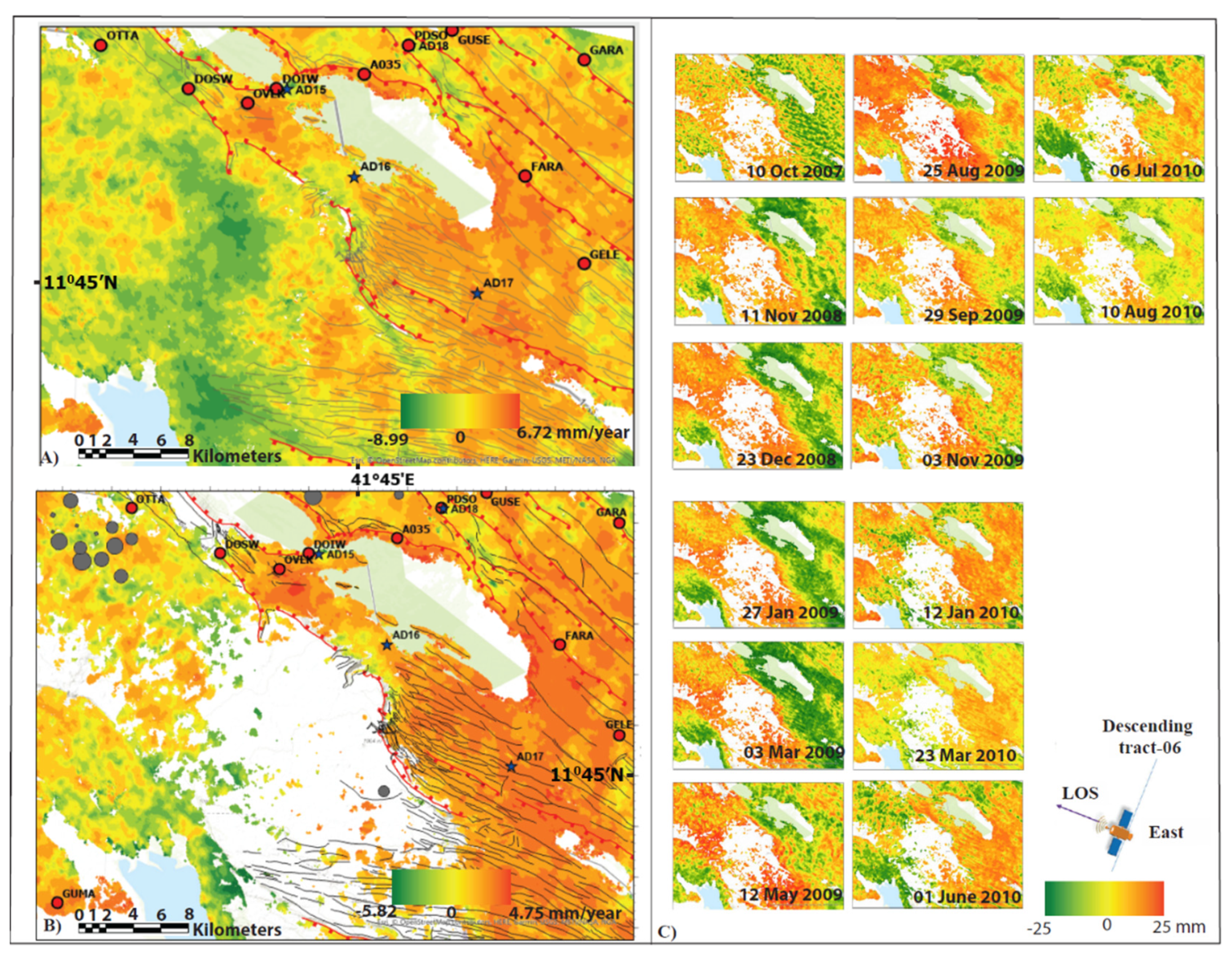
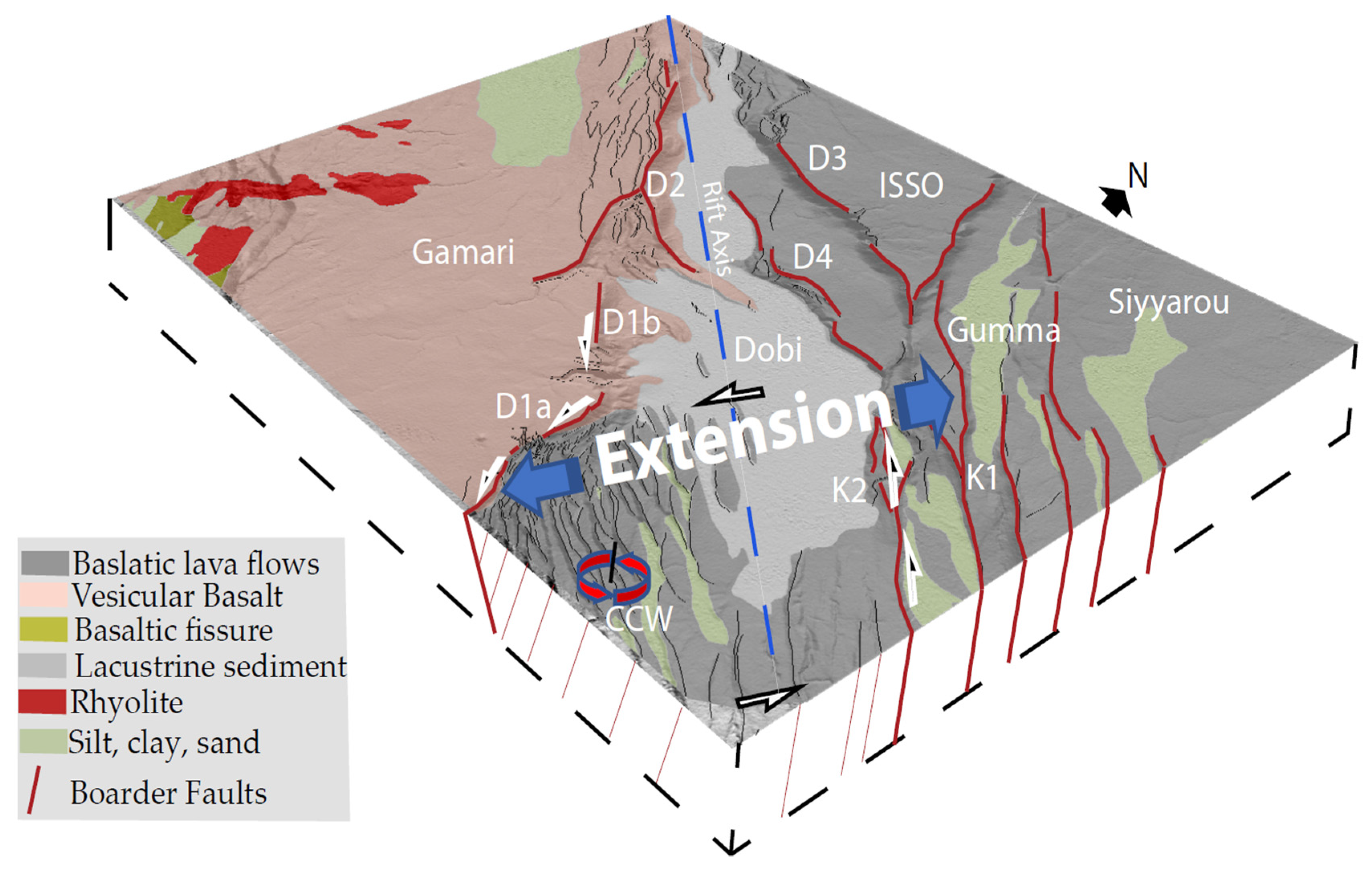
Publisher’s Note: MDPI stays neutral with regard to jurisdictional claims in published maps and institutional affiliations. |
© 2022 by the authors. Licensee MDPI, Basel, Switzerland. This article is an open access article distributed under the terms and conditions of the Creative Commons Attribution (CC BY) license (https://creativecommons.org/licenses/by/4.0/).
Share and Cite
Demissie, Z.S.; Rimmington, G. Surface Displacements Mechanism of the Dobi Graben from ASAR Time-Series Analysis of InSAR: Implications for the Tectonic Setting in the Central Afar Depression, Ethiopia. Remote Sens. 2022, 14, 1845. https://doi.org/10.3390/rs14081845
Demissie ZS, Rimmington G. Surface Displacements Mechanism of the Dobi Graben from ASAR Time-Series Analysis of InSAR: Implications for the Tectonic Setting in the Central Afar Depression, Ethiopia. Remote Sensing. 2022; 14(8):1845. https://doi.org/10.3390/rs14081845
Chicago/Turabian StyleDemissie, Zelalem S., and Glyn Rimmington. 2022. "Surface Displacements Mechanism of the Dobi Graben from ASAR Time-Series Analysis of InSAR: Implications for the Tectonic Setting in the Central Afar Depression, Ethiopia" Remote Sensing 14, no. 8: 1845. https://doi.org/10.3390/rs14081845
APA StyleDemissie, Z. S., & Rimmington, G. (2022). Surface Displacements Mechanism of the Dobi Graben from ASAR Time-Series Analysis of InSAR: Implications for the Tectonic Setting in the Central Afar Depression, Ethiopia. Remote Sensing, 14(8), 1845. https://doi.org/10.3390/rs14081845





